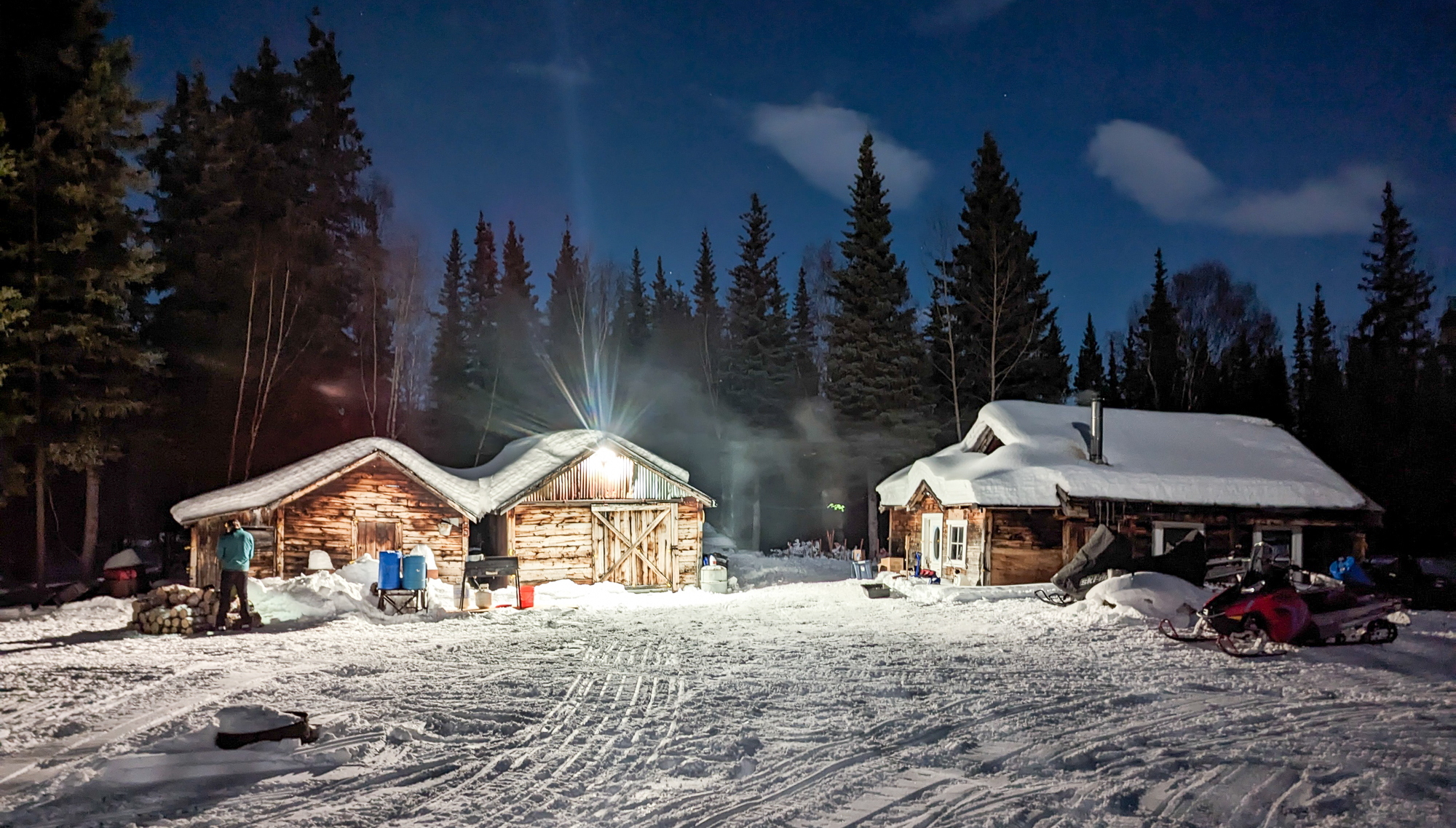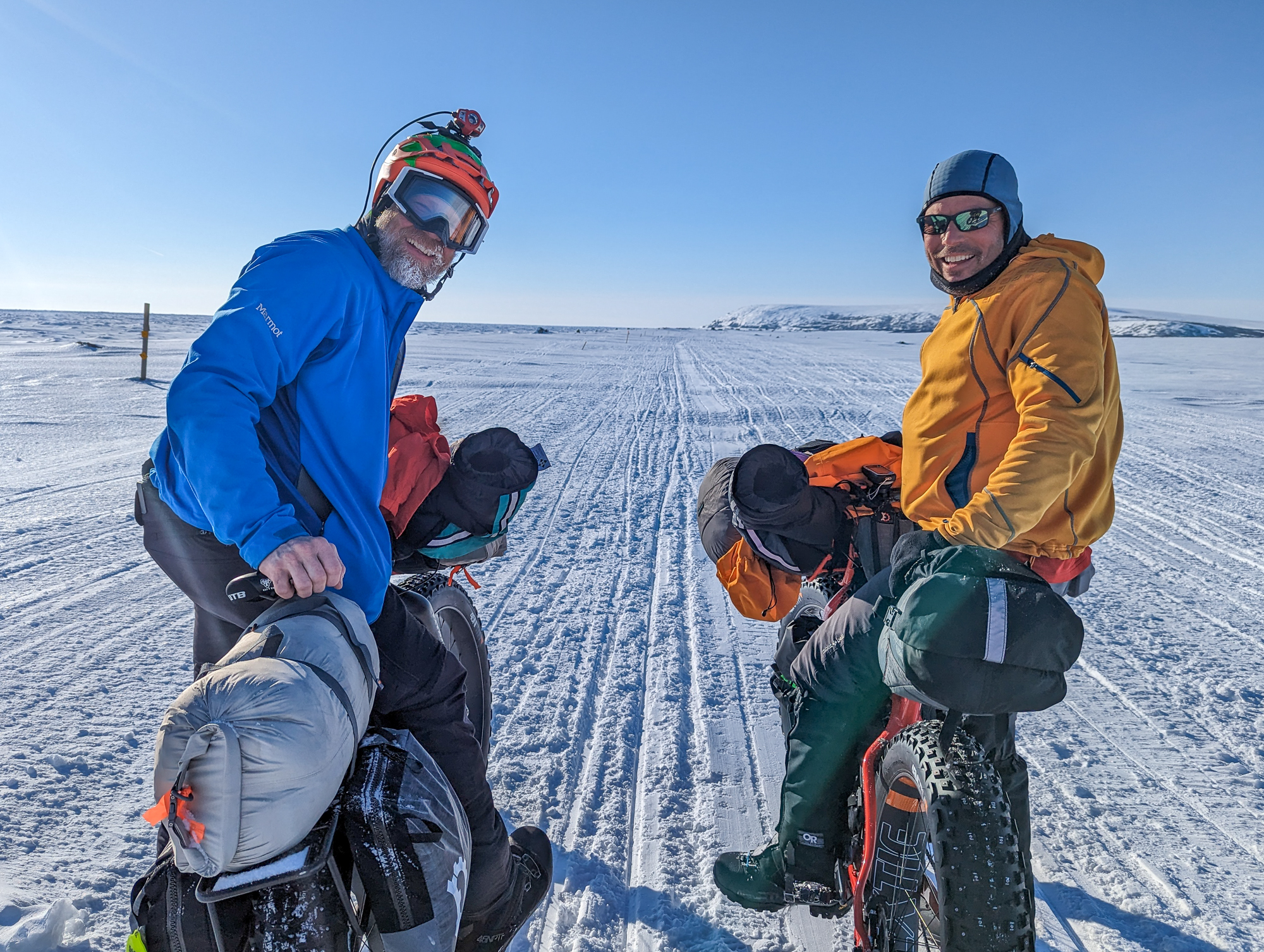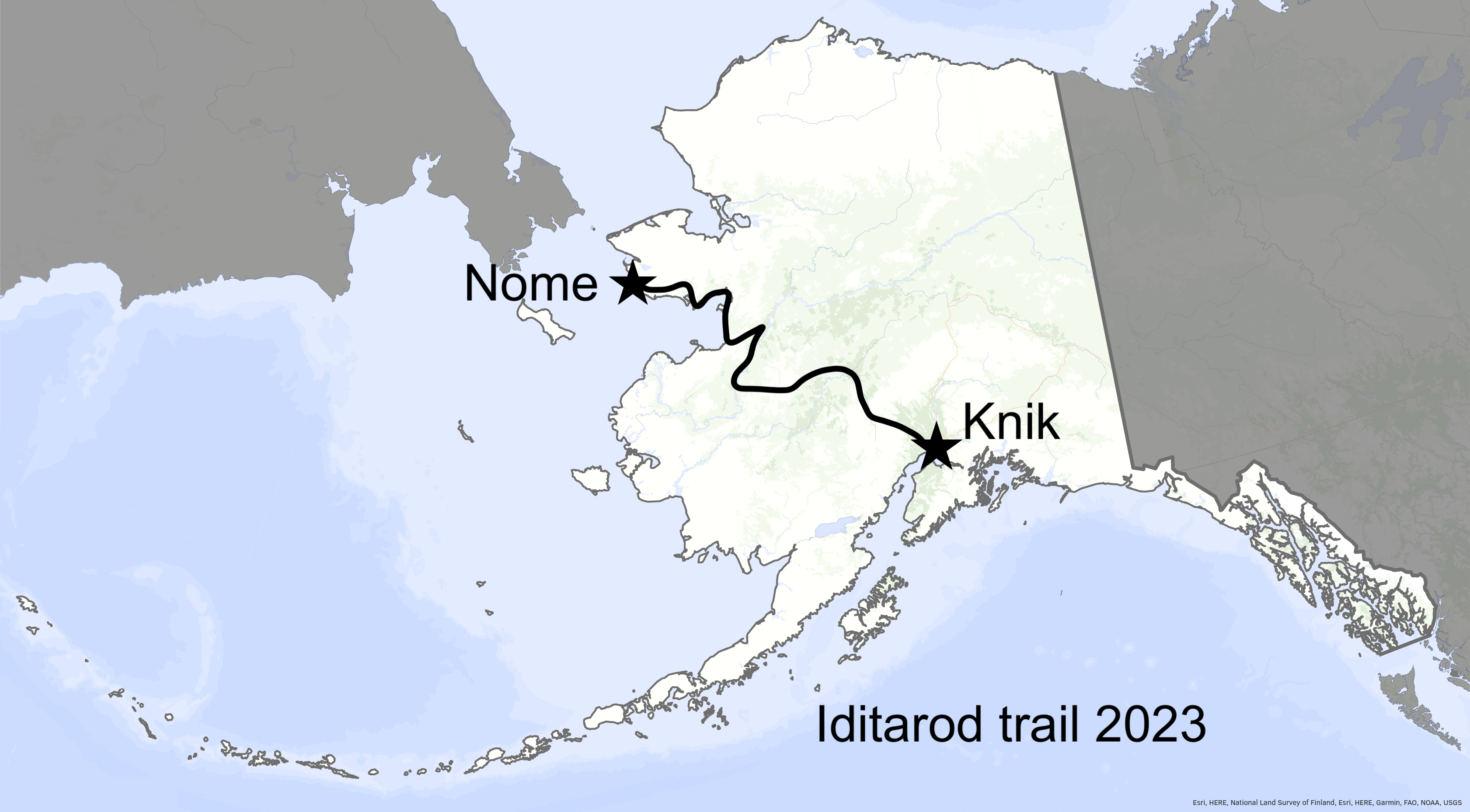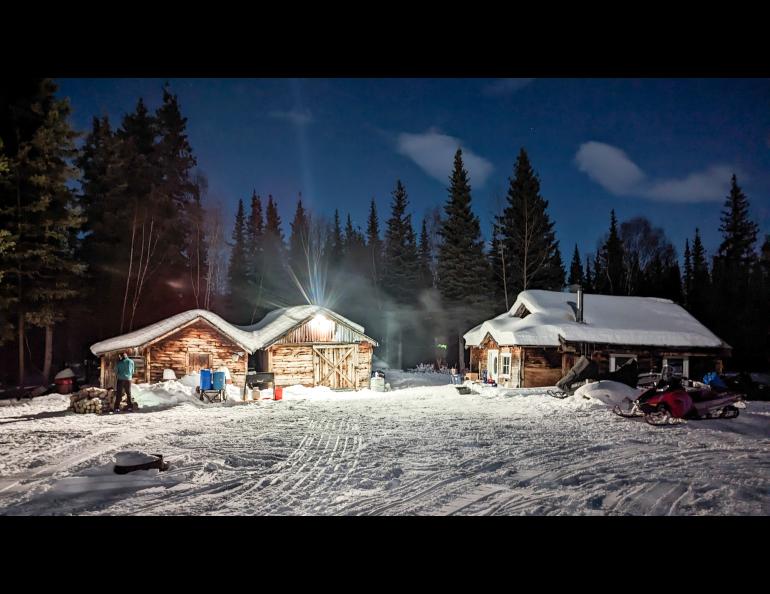
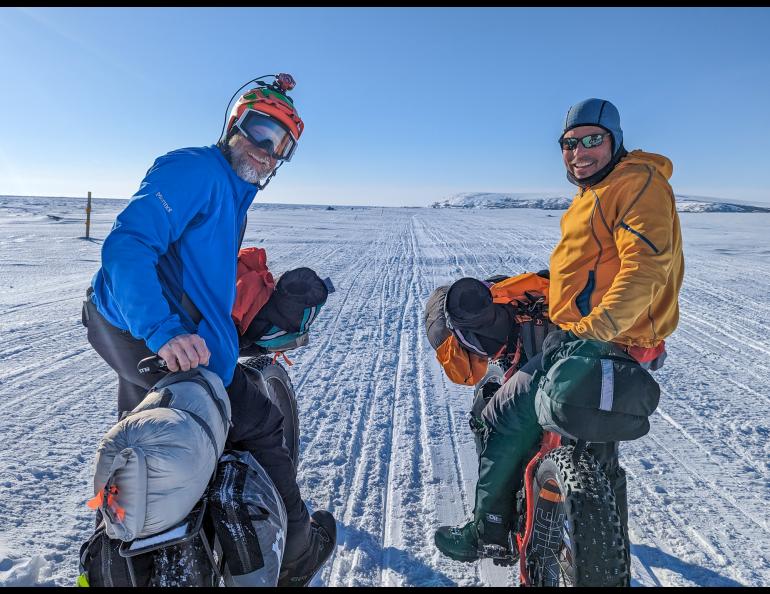
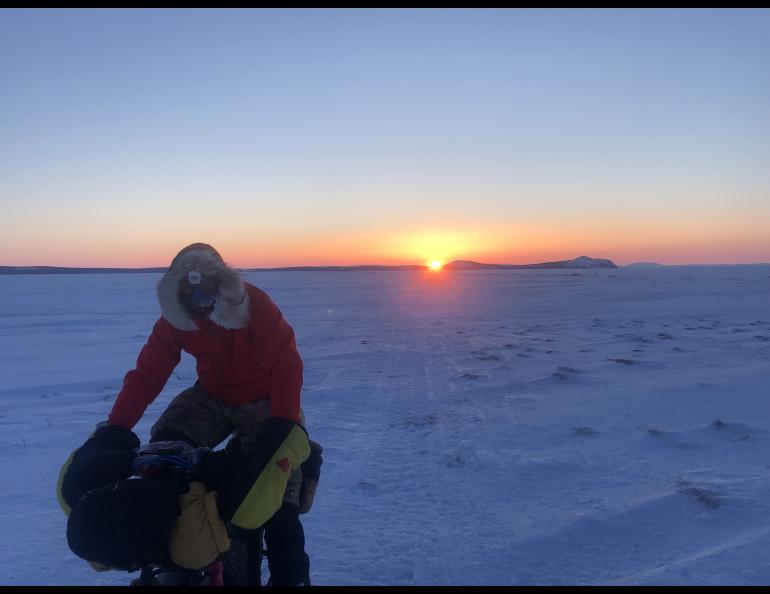
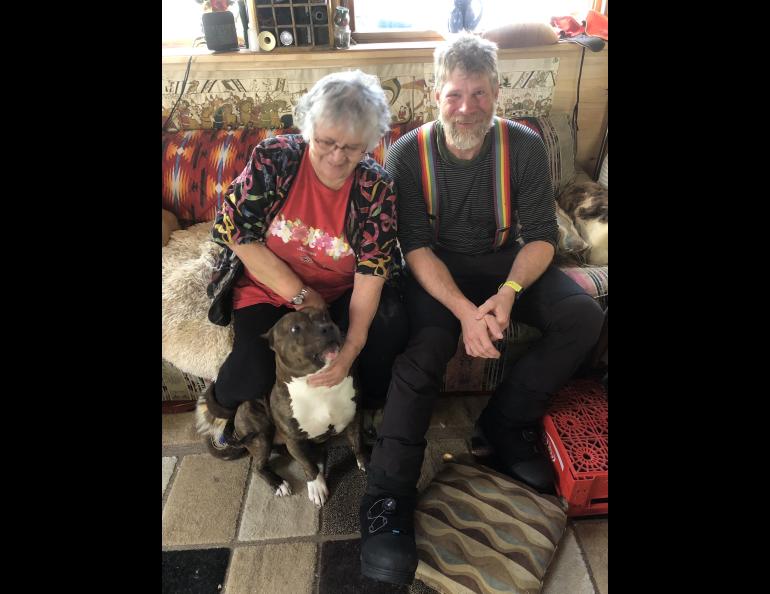
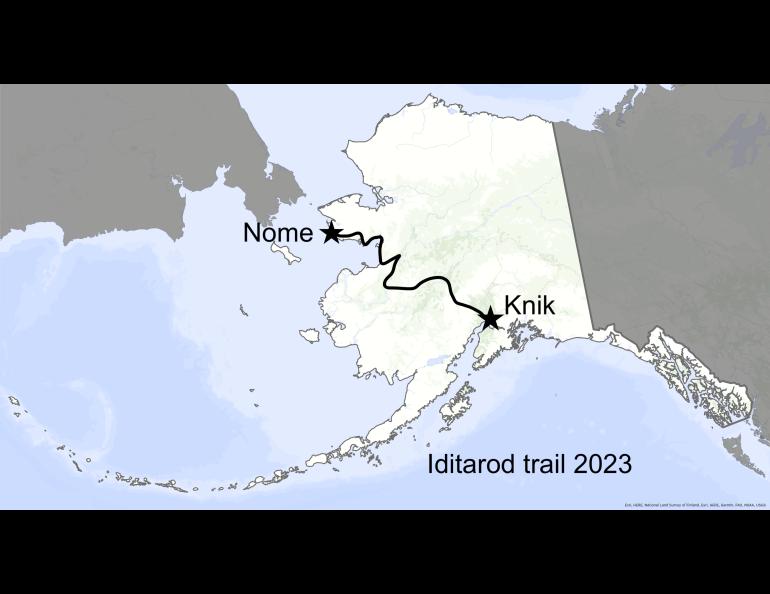
One thousand miles of Iditarod trail by bike
Two staff members of the University of Alaska Fairbanks recently rode 1,000 miles across Alaska on bikes with tires fat as a loaf of bread.
Jamie Hollingsworth is a do-all field guy with the Institute of Arctic Biology and site manager of Bonanza Creek Long Term Ecological Research program. Jay Cable is a research programmer with the Geographical Information Network of Alaska at the Geophysical Institute.
From Knik (north of Anchorage), on packed-snow trails, they rode most of the way to Nome on the Iditarod Trail with Bill Fleming, owner of the Trek Bicycle Shop in Anchorage. The trio finished the journey together in 18 days, four hours.
During a human-powered journey of that length, things will not go as planned. For Hollingsworth and Cable, this included having to wait for people driving snowmachines to pack down trail for them as they hung out in both McGrath and the outpost of Ophir. The bikers were then just ahead of Iditarod dog teams and mushers, who started the race in Anchorage on March 5, 2023.
Another challenging factor was a steady winter rainfall they experienced about halfway into their journey at a cabin 20 miles outside of the ghost town of Iditarod. As they listened to rain tap on the metal roof of the shelter, the trail underwent a transformation.
“The snowpack was getting pretty squishy at that point,” Cable said.
As water dripped off the cabin, the bikers had a pleasant distraction from above. Using handheld satellite texters, they communicated with friend and forecaster Ed Plumb of the National Weather Service in Fairbanks.
“We were very excited to get updates about the weather,” Cable said.
Plumb wrote them that the rain had turned to snow to the west of them; colder weather was coming. This was heartening to the riders, who hoped the trail would freeze and give them good riding, which is exactly what happened.
“It was a sidewalk from Iditarod to Shageluk,” said Hollingsworth, 50, on his first ride to Nome.
“The trail was the best I’ve ever seen from Iditarod to Nome,” said Cable, 49, who completed the Iditarod trail on bike for the fourth time in 2023.
Cable is a lifelong Alaskan whose friends apply a Jay Filter to his cheery trail reports. They know his descriptions of great days include no mention of biting winds or soft trails that require miles of shoving a bike.
Though Cable said things were changing too quickly on the trail to use any of the satellite views of Alaska he creates at work, he noted those instruments orbiting thousands of miles over the Alaska wilderness made a difference in their trip.
In addition to the weather reports they received on their handheld units when they were far from cellphone towers, the three bikers (and all the racers in the Iditarod Trail Invitational, of which they were a part) carried tiny transmitters. Those little wafers sent frequent signals to satellites, enabling anyone to track their progress across the Alaska map on a website.
“Everyone was aware of us, everywhere we went,” Hollingsworth said.
For example, the owner of a restaurant in Unalakleet knew they were coming and quickly baked them up a few pizzas. The principal of the Golovin school ushered the riders in for a hot meal after seeing their approach on his computer. Using signals bounced from space, an experienced friend urged them to make a long day into a super-long day along Alaska’s west coast.
“The Coast” is a section of the Iditarod Trail from Unalakleet to Nome where the ocean meets Alaska’s western shore. It features large expanses of open country with nothing to block the wind. The trail also includes an ocean crossing between the villages of Shaktoolik and Koyuk. There, trailbreakers lay a path on sea ice, which forms in places where the ocean gets cold enough to freeze.
As the trio of riders was approaching the windy village of Shaktoolik, Hollingsworth’s satellite texter pinged. It was from Jeff Oatley of Fairbanks, who once rode from Knik to Nome in just 10 days and 3 hours. In 2017, he topped that by riding both the Yukon Quest and Iditarod trails in one shot.
“You guys need to keep moving,” Oatley texted after seeing the weather forecast of an extreme windstorm due to hit western Alaska. “Do everything you can to get across tonight.”
Oatley was referencing the sea-ice passage from Shaktoolik to the village of Koyuk. Though the men had already ridden almost 50 miles that day, they bypassed a shelter cabin between the two villages.
“We were trying to beat the headwind into Koyuk,” Cable said. “We missed by two hours.”
In that extreme blow, Hollingsworth wished he had a jacket with a fur ruff that zipped into a tunnel like the one Cable wore. Though Hollingsworth had a similar setup, it was not as bombproof. He rode with one hand in front of his face trying to block the wind.
When the riders got to the shelter of the school in Koyuk, Hollingsworth could no longer see out of his left eye. He has a condition that limits his night vision and wondered if the new malady might force him to quit the trip.
“I was really nervous,” he said.
In Koyuk, the extreme wind pinned the riders, who were then predisposed to near-perpetual motion. That 24-hour delay was well-timed for Hollingsworth, whose frostbitten eye had more hours to heal. The time also allowed him to buy a pair of goggles in the village store.
When the wind died, the trio got back on the trail. With a break to eat moose sandwiches in Golovin, they rode for another long burst to the village of White Mountain. That was their last stay with friends who had tracked them on the internet and were ready with conversation, food and a warm place to sleep.
“The openness and hospitality of people on the trail was super cool,” Hollingsworth said.
From that lovely village on the Fish River, which is the final place Iditarod mushers are required to rest about 70 miles from Nome, the bikers took off again. On the final stretch to Nome the bikers met Oatley and his wife Heather Best, who had ridden from Nome to see them after flying in from their home in Fairbanks.
The riders continued past a shelter cabin and stopped one final time at the Safety Roadhouse, 22 miles from Nome. There, two women from Texas who had helicoptered in from Nome for the Iditarod bought the three fat-bikers lunch.
Hollingsworth, Cable and Fleming then finished their 70-mile day — and their 1,000-mile trip — by cruising down snow-packed Front Street in Nome. They rolled to the arch of burled sprucewood that marks the finish of Iditarod.
“Because there were mushers coming in, people on the sidewalks were cheering and taking pictures of us,” said Hollingsworth, who wants to repeat the experience someday soon. “It was super surreal.
“We were getting to experience the trail like very few people do,” he said. “There’s definitely a physical component, but it’s a huge mental game to be pushing your bike and see a sign that says ‘20 miles to Nikolai,’ and say to yourself ‘It’s only 20 miles. I’ll get there in 10 hours.’”

